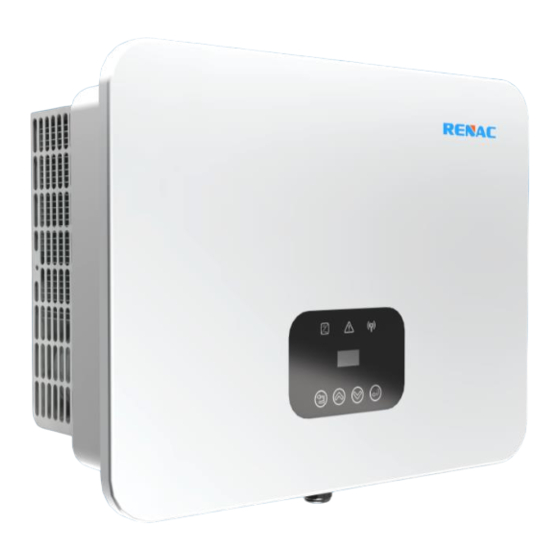
Table of Contents
Advertisement
Quick Links
Advertisement
Table of Contents

Summarization of Contents
1. Introduction
1.1 Introduction
Describes solar inverters R3-15K/R3-17K/R3-20K/R3-25K, assuming user familiarity with electrical installations.
1.2 Applied Designations
Explains the different levels of information and symbols used throughout the manual for clarity and safety.
1.3 Important Safety Information
Critical safety guidelines to be read and understood before installing, operating, or maintaining the inverter.
1.4 System Sizing
Guidance on dimensioning photovoltaic systems, ensuring PV string voltage does not exceed limits.
2. Technical Description of Inverters
2.1 Mechanical Design
Presents the outline dimensions and identifies key physical components of the R3 inverter series.
2.2 Electrical System Design
Illustrates the internal electrical configuration and wiring diagram of the inverter system.
2.3 Technical Data
Detailed specifications for PV input, AC output, efficiency, and protection features across models.
2.4 Grid Codes
Lists supported national and regional grid codes required for compliant inverter operation.
3. Installation and Startup
3.1 Package Information
Details the components included in the inverter package for installation purposes.
3.2 Installation Environment
Specifies ideal environmental conditions for inverter placement to ensure optimal performance.
3.3 Installation Position
Provides guidance on selecting the correct mounting location and necessary clearances for the inverter.
3.4 Mounting Procedure
Step-by-step instructions for securely mounting the inverter onto a wall or surface.
3.5.1 Connection to the Grid (AC Output)
Detailed process for connecting the inverter's AC output to the power grid, including safety measures.
3.5.2 Connection to PV String (DC Input)
Guidance on correctly connecting photovoltaic (PV) strings to the inverter's DC input terminals.
3.5.3.1 RCR Port (Europe Standard)
Wiring instructions for the RCR port, used for ripple control signals in European grids.
3.5.3.2 COM Port
Details on connecting communication modules (WIFI/4G/Ethernet) to the COM port.
3.5.3.3 USB Port
Information regarding the use of the USB port for local software upgrades.
3.5.3.4 Meter Connection
Procedure for connecting an intelligent electricity meter for export control functions.
3.5.3.5 RS485 Connection
Steps for configuring RS485 communication for multi-inverter setups.
3.6 Starting the Inverter
Procedure for safely powering on and commissioning the inverter after installation.
4. User Interface
4.1 Led and Key
Description of the inverter's LED indicators and control buttons for operation status.
4.2.1 Setting Language
Instructions to change the display language on the inverter's LCD screen.
4.2.2 Setting Date & Time
Steps to adjust the date and time settings shown on the inverter's LCD.
4.2.3 Setting PV Configuration
Guidance on configuring photovoltaic (PV) system parameters via the LCD menu.
4.2.4 Setting Communication Address
Procedure for setting communication addresses for various interfaces (COM, Meter).
4.2.5 Setting Safety
Configuration of safety parameters and grid protection settings through the user interface.
4.2.6 Setting Export Control
How to set the inverter's power export limitations and control features.
4.2.7 Upgrading the Inverter
Detailed steps for performing software upgrades on the inverter using a USB drive.
4.2.8 Factory Reset
Instructions for resetting the inverter to its original factory default settings.
4.2.9 Error Logs
Accessing and interpreting error logs from the inverter for troubleshooting purposes.
4.2.10 About
Displays information about the inverter, including model, serial number, and firmware versions.
4.3 Self-Test in Accordance with CEI 0-21
Procedure for executing the CEI 0-21 self-test, mandatory for Italian grid-connected inverters.
5. Warranty
5.1 Warranty Claim Procedure
Steps required to file a warranty claim for a malfunctioning inverter.
5.2 Service After Warranty Expiration
Information on available service options and associated costs for out-of-warranty inverters.
6. Maintenance
6.1 Routine Maintenance
Guidelines for regular maintenance checks and cleaning to ensure inverter longevity and performance.
6.2 Fan Maintenance
Instructions for cleaning, checking, and potentially replacing the inverter's cooling fan.













Need help?
Do you have a question about the R3-20K and is the answer not in the manual?
Questions and answers